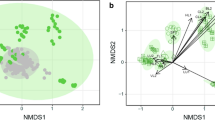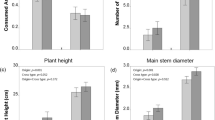Abstract
Mechanisms contributing to the invasive success of plants are still only partly understood. A main assumption is that an escape from specialized enemies in introduced ranges allows a reduction of chemical defences resulting in an increase in growth and reproduction and thus increased competitive ability of introduced plants. Not only variation in concentration but also variation in composition of chemical compounds between individuals may be a key advantage for plants introduced to novel areas impeding adaptation of different plant antagonists. To investigate quantitative and qualitative variation of putative defence compounds and investment of resources in growth, we conducted a common garden experiment in the native range with seeds of 13 native and 9 introduced populations of Tanacetum vulgare, an aromatic plant forming different chemotypes. After 3.5 months, plants of introduced populations had similar biomass but more stems and higher concentrations of volatile secondary compounds (mainly terpenes) than plants of native populations. Both native and invasive T. vulgare populations exhibited high chemotypic variation with nine chemotypes occurring on both continents, whereas several were found exclusively either in plants originating from the native (n = 10) or invasive (n = 2) range. Due to the known negative effects of many mono- and sesquiterpenes on various organisms, we propose that high concentrations of these secondary compounds accompanied by high chemotypic diversity may facilitate the invasion success of a plant species.


Similar content being viewed by others
References
Adams RP (2007) Identification of essential oil components by gas chromatography/mass spectrometry, 4th edn. Allured Publishing Corporation, Illinois
Barra A (2009) Factors affecting chemical variability of essential oils: a review of recent developments. Nat Prod Commun 4:1147–1154
Benjamini Y, Hochberg Y (1995) Controlling the false discovery rate—a practical and powerful approach to multiple testing. J R Stat Soc Series B Stat Methodol 57:289–300
Berenbaum MR, Zangerl AR (2006) Parsnip webworms and host plants at home and abroad: trophic complexity in a geographic mosaic. Ecology 87:3070–3081. doi:10.1890/0012-9658(2006)87[3070:PWAHPA]2.0.CO;2
Blossey B, Nötzold R (1995) Evolution of increased competitive ability in invasive nonindigenous plants: a hypothesis. J Ecol 83:887–889
Bossdorf O, Auge H, Lafuma L, Rogers WE, Siemann E, Prati D (2005) Phenotypic and genetic differentiation between native and introduced plant populations. Oecologia 144:1–11. doi:10.1007/s00442-005-0070-z
Colautti RI, Maron JL, Barrett SCH (2009) Common garden comparisons of native and introduced plant populations: latitudinal clines can obscure evolutionary inferences. Evol Appl 2:187–199. doi:10.1111/j.1752-4571.2008.00053.x
Davis MA (2009) Invasion biology. Oxford University Press, Oxford
Doorduin LJ, Vrieling K (2011) A review of the phytochemical support for the shifting defence hypothesis. Phytochem Rev 10:99–106. doi:10.1007/s11101-010-9195-8
Doorduin LJ, van den Hof K, Vrieling K, Joshi J (2010) The lack of genetic bottleneck in invasive Tansy ragwort populations suggests multiple source populations. Basic Appl Ecol 11:244–250. doi:10.1016/j.base.2009.12.007
Dorman HJD, Deans SG (2000) Antimicrobial agents from plants: antibacterial activity of plant volatile oils. J Appl Microbiol 88:308–316. doi:10.1046/j.1365-2672.2000.00969.x
Fox LR (1981) Defense and dynamics in plant-herbivore systems. Am Zool 21:853–864. doi:10.1093/icb/21.4.853
Gershenzon J (1994) Metabolic costs of terpenoid accumulation in higher plants. J Chem Ecol 20:1281–1328. doi:10.1007/BF02059810
Gershenzon J, Dudareva N (2007) The function of terpene natural products in the natural world. Nat Chem Biol 3:408–414. doi:10.1038/nchembio.2007.5
Holden ANG, Mahlberg PG (1992) Application of chemotaxonomy of leafy spurges (Euphorbia spp) in biological control. Can J Bot 70:1529–1536
Holopainen M, Hiltunen R, von Schantz M (1987) A study on tansy chemotypes. Planta Med 53:284–287. doi:10.1055/s-2006-962707
Joshi J, Vrieling K (2005) The enemy release and EICA hypothesis revisited: incorporating the fundamental difference between specialist and generalist herbivores. Ecol Lett 8:704–714. doi:10.1111/j.1461-0248.2005.00769.x
Keane RM, Crawley MJ (2002) Exotic plant invasions and the enemy release hypothesis. Trends Ecol Evol 17:164–170. doi:10.1016/S0169-5347(02)02499-0
Keskitalo M, Pehu E, Simon JE (2001) Variation in volatile compounds from tansy (Tanacetum vulgare L.) related to genetic and morphological differences of genotypes. Biochem Syst Ecol 29:267–285. doi:10.1016/S0305-1978(00)00056-9
Kleine S, Müller C (2011) Intraspecific plant chemical diversity and its relation to herbivory. Oecologia 166:175–186. doi:10.1007/s00442-010-1827-6
Macel M, Klinkhamer PGL (2010) Chemotype of Senecio jacobaea affects damage by pathogens and insect herbivores in the field. Evol Ecol 24:237–250. doi:10.1007/s10682-009-9303-7
Mihaliak CA, Couvet D, Lincoln DE (1987) Inhibition of feeding by a generalist insect due to increased volatile leaf terpenes under nitrate-limiting conditions. J Chem Ecol 13:2059–2067. doi:10.1007/BF01012871
Mitich LW (1992) Intriguing world of weeds: tansy. Weed Technol 6:242–244
Müller C, Hilker M (2001) Host finding and oviposition behavior in a chrysomelid specialist—the importance of host plant surface waxes. J Chem Ecol 27:985–994. doi:10.1023/A:1010343205114
Müller C, Martens N (2005) Testing predictions of the ‘evolution of increased competitive ability’ hypothesis for an invasive crucifer. Evol Ecol 19:533–550. doi:10.1007/s10682-005-1022-0
Müller-Schärer H, Schaffner U, Steinger T (2004) Evolution in invasive plants: implications for biological control. Trends Ecol Evol 19:417–422. doi:10.1016/j.tree.2004.05.010
Nerio LS, Olivero-Verbel J, Stashenko E (2010) Repellent activity of essential oils: a review. Bioresour Technol 101:372–378. doi:10.1016/j.biortech.2009.07.048
Newcombe G (2003) Puccinia tanaceti: specialist or generalist? Mycol Res 107:797–802. doi:10.1017/S0953756203008025
Orians CM, Ward D (2010) Evolution of plant defenses in nonindigenous environments. Annu Rev Entomol 55:439–459. doi:10.1146/annurev-ento-112408-085333
Pielou EC (1966) The measurement of diversity in different types of biological collections. J Theor Biol 13:131–144. doi:10.1016/0022-5193(66)90013-0
Randrianalijaona JA, Ramanoelina PAR, Rasoarahona JRE, Gaydou EM (2005) Seasonal and chemotype influences on the chemical composition of Lantanacamara L.—essential oils from Madagascar. Anal Chim Acta 545:46–52. doi:10.1016/j.aca.2005.04.028
Roman J, Darling JA (2007) Paradox lost: genetic diversity and the success of aquatic invasions. Trends Ecol Evol 22:454–464. doi:10.1016/j.tree.2007.07.002
Schmitz G (1998) The phytophagous insect fauna of Tanacetum vulgare L. (Asteraceae) in Central Europe. Beitr Entomol 48:219–235
Shannon CE, Weaver W (1949) The mathematical theory of communication. University of Illinois Press, Urbana
Stamp N (2003) Out of the quagmire of plant defence hypotheses. Q Rev Biol 78:23–55
Susurluk H, Caliskan Z, Gürkan O, Kirmizigül S, Gören N (2007) Antifeedant activity of some Tanacetum species and bioassay guided isolation of the secondary metabolites of Tanacetum cadmeum ssp cadmeum (Compositae). Ind Crop Prod 26:220–228. doi:10.1016/j.indcrop.2007.04.002
Thompson JN (2005) Coevolution: the geographic mosaic of coevolutionary arms races. Curr Biol 15:R992–R994. doi:10.1016/j.cub.2005.11.046
Thompson JD, Chalchat JC, Michet A, Linhart YB, Ehlers B (2003) Qualitative and quantitative variation in monoterpene co-occurrence and composition in the essential oil of Thymus vulgaris chemotypes. J Chem Ecol 29:859–880. doi:10.1023/A:1022927615442
van der Meijden E (1996) Plant defence, an evolutionary dilemma: contrasting effects of (specialist and generalist) herbivores and natural enemies. Entomol Exp Appl 80:307–310. doi:10.1007/BF00194780
Ward JH (1963) Hierarchical grouping to optimize an objective function. J Am Stat Assoc 58:236–244
West BT, Welch KB, Galecki AT (2007) Linear mixed models: a practical guide using statistical software. Chapman & Hall, Boca Raton
Wheeler GS, Pratt PD, Giblin-DaviS RM, Ordung KM (2007) Intraspecific variation of Melaleuca quinquenervia leaf oils in its naturalized range in Florida, the Caribbean, and Hawaii. Biochem Sys Ecol 35:489–500. doi:10.1016/j.bse.2007.03.007
Williams CA, Harborne JB, Eagles J (1999) Variations in lipophilic and polar flavonoids in the genus Tanacetum. Phytochemistry 52:1301–1306. doi:10.1016/S0031-9422(99)00425-2
Williamson M, Fitter A (1996) The varying success of invaders. Ecology 77:1661–1666. doi:10.2307/2265769
Acknowledgments
We thank K. Rondeau and B. Teichner for their lab and field assistance. Seeds were provided by G. Fayvush, R. Tanner, A. Sennikov, R. Wittenberg, S. Toepfer, A. Diaconu, I. Toševski, M. Dolgovskaya, M. Volkovitch, S. Mosyakin, A. McClay, S. Cesselli, S. Turner, B. Villegas, M. Pitcairn, M. Chandler, J. Story, R. Sforza and M. Cristofaro. We also thank A. Schwan for English correction. We gratefully acknowledge M. Chandler and A. McClay, co-leaders of the common tansy project in the U. S. A. and Canada, and the financial support of the Montana Noxious Weed Trust Fund through the Montana State University and the Minnesota Department of Agriculture in the U. S. A., and in Canada the Alberta Beef Producers, the Agriculture and Food Council of Alberta (Advancing Canadian Agriculture and Agri-Food Program), the Saskatchewan Agriculture and Food (Agriculture Development Fund), Enbridge Pipelines (Athabasca), EnCana Oil & Gas Partnership and the British Columbia Department of Forests and Range.
Author information
Authors and Affiliations
Corresponding author
Rights and permissions
About this article
Cite this article
Wolf, V.C., Berger, U., Gassmann, A. et al. High chemical diversity of a plant species is accompanied by increased chemical defence in invasive populations. Biol Invasions 13, 2091–2102 (2011). https://doi.org/10.1007/s10530-011-0028-5
Received:
Accepted:
Published:
Issue Date:
DOI: https://doi.org/10.1007/s10530-011-0028-5




